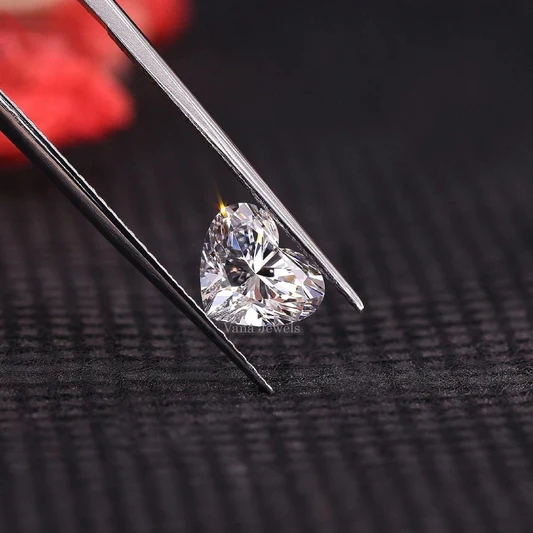Moissanite vs Diamond: Breaking Down the Key Differences
"Explore the key differences between Moissanite vs Diamond. Learn about sparkle, price, durability, and ethical considerations in this comparison."

The debate between moissanite vs diamond has been gaining traction in recent years as more consumers are looking for alternatives to traditional diamonds. Whether you're shopping for an engagement ring, a necklace, or simply exploring the world of fine jewelry, understanding the difference between Moissanite and Diamond is essential. This article breaks down the key differences between these two gemstones to help you make an informed decision.
What is a Moissanite Diamond?
Before diving into the comparisons, let’s answer the burning question: What is a Moissanite diamond?
Moissanite is a gemstone that was discovered in 1893 by French chemist Henri Moissan. Originally, Moissan found it in a meteor crater, leading to its nickname as "the gemstone from the stars." While Moissanite is often compared to diamonds because of its brilliance and appearance, it is not a diamond. Moissanite is made from silicon carbide and is lab-created, which makes it much more affordable than natural diamonds.
A Moissanite diamond, as people commonly refer to it, is simply Moissanite cut and polished to resemble a traditional diamond. Its hardness, brilliance, and sparkle are what make it a popular alternative to diamonds.
Moissanite vs Diamond: Quick Comparison
Let’s start with a high-level comparison of the two stones.
-
Brilliance: Moissanite has a higher refractive index, meaning it sparkles more than diamonds. It reflects light in a rainbow-like effect, giving it an extra “wow” factor.
-
Price: Moissanite is significantly cheaper than diamonds, sometimes by as much as 90%.
-
Durability: Diamonds score a perfect 10 on the Mohs scale of hardness, making them incredibly durable. Moissanite scores 9.25, which is still quite durable, but a notch lower.
-
Color and Clarity: While diamonds are graded for color and clarity, Moissanite generally has fewer visible imperfections. However, it may have a slight yellow or gray tint in some cases.
Sparkle and Brilliance: Moissanite vs Diamond
Brilliance is one of the most defining features of Moissanite and Diamonds.
Moissanite has a refractive index of 2.65-2.69, which is higher than a diamond’s 2.42. This means that Moissanite bends light more efficiently, resulting in an enhanced sparkle. When you look at Moissanite, you’ll notice more flashes of color—often compared to a rainbow—due to its higher dispersion of light. Diamonds, on the other hand, are more subdued in terms of color dispersion.
If you’re looking for a stone that sparkles a bit more than a traditional diamond, Moissanite’s brilliance will certainly impress you.
Price Differences: Moissanite vs Diamond
One of the biggest differences between what is a moissanite diamond is the price.
Moissanite is significantly more affordable than diamonds. The cost savings can be staggering—Moissanite prices are often 90% less than diamonds of similar size and quality. For example, a 1-carat Moissanite stone can cost anywhere from $500 to $600, while a similar diamond would easily run over $5,000.
Why is Moissanite so much cheaper? It’s primarily due to its lab-created nature and the fact that Moissanite gemstones don’t require the extensive mining operations that diamonds do. Thus, it’s a win-win for those seeking affordable luxury.
Durability and Hardness
When it comes to durability, diamonds reign supreme. They are the hardest natural substance on Earth, scoring a perfect 10 on the Mohs scale of hardness. This means they can withstand scratches and damage far better than most other stones.
However, Moissanite is still highly durable, scoring 9.25 on the Mohs scale. This makes it an excellent choice for everyday wear and ensures it will retain its beauty over time. Moissanite can be scratched more easily than diamonds but is still highly resistant to breakage.
Color and Clarity: Moissanite vs Diamond
Diamonds are graded on a color scale from D (colorless) to Z (yellow or brown). Moissanite, being a lab-created stone, typically has a slightly yellow or grayish hue, though higher-quality Moissanite stones can be close to colorless.
In terms of clarity, Moissanites tend to be near-flawless or flawless with fewer inclusions, making them visually cleaner compared to many diamonds. This gives Moissanite an edge in terms of visual appeal since it’s often free of visible imperfections.
Ethical Considerations: Moissanite vs Diamond
Ethical concerns regarding diamonds have become more prevalent, especially with the rise of conflict diamonds, which are mined in war zones and sold to fund violence. In contrast, Moissanite is ethically produced in labs, so it doesn’t contribute to the negative impact that diamond mining can have on both people and the environment.
For individuals concerned about sustainability and ethical sourcing, Moissanite is often the preferred choice.
Moissanite vs Diamond in Engagement Rings
Moissanite is becoming a popular alternative for engagement rings due to its stunning sparkle, lower cost, and ethical benefits. Many people are now opting for Moissanite in their engagement rings because they can get a larger, more brilliant stone for a fraction of the cost of a diamond.
Additionally, the durability of Moissanite makes it a smart choice for everyday wear, and its affordability allows you to invest in a beautiful band or setting.
Longevity and Resale Value: Moissanite vs Diamond
While diamonds tend to hold their value better over time, difference between moissanite and diamond don’t have the same resale value. However, they last a long time if properly cared for and are a great value upfront.
For those seeking an investment piece that will appreciate in value, diamonds might be the better option. For those focused on immediate beauty and affordability, Moissanite is a fantastic choice.
Moissanite vs Diamond: Which One Is Right for You?
The choice between Moissanite and Diamond ultimately depends on your priorities. If you’re looking for a beautiful, ethical, and budget-friendly option, Moissanite is an excellent choice. However, if you value tradition, longevity, and resale value, a diamond may still be the right decision.
The Science Behind Moissanite and Diamond
The difference between Moissanite vs Diamond can be traced back to their chemical composition. Moissanite is made of silicon carbide, while diamonds are composed entirely of carbon. This leads to differences in how the two stones interact with light, contributing to their visual differences.
Customer Preferences: Why Moissanite is Gaining Popularity
As more consumers become aware of Moissanite's benefits, its popularity continues to rise. People are embracing its brilliance, affordability, and ethical production, choosing it over diamonds in increasing numbers.
Moissanite vs Diamond: Pros and Cons
Moissanite Pros:
-
Affordable
-
Greater brilliance and sparkle
-
Ethical sourcing
Moissanite Cons:
-
Slightly lower hardness
-
Limited resale value
Diamond Pros:
-
Timeless and traditional appeal
-
Strong resale value
-
Highly durable
Diamond Cons:
-
Expensive
-
Ethical concerns regarding mining
Conclusion
Both Moissanite vs Diamond have their unique qualities, but for many people, Moissanite offers the better value. Whether you prioritize brilliance, ethical concerns, or affordability, Moissanite stands as a stunning alternative to traditional diamonds.
FAQs
-
Is Moissanite as durable as a diamond?
Moissanite is durable but slightly softer than diamonds. It’s still an excellent choice for everyday wear.
-
Does Moissanite sparkle more than diamonds?
Yes, Moissanite has more brilliance and sparkle than diamonds due to its higher refractive index.
-
Is Moissanite more affordable than diamonds?
Yes, Moissanite is generally much more affordable than diamonds, sometimes by up to 90%.
-
Can Moissanite be used in engagement rings?
Absolutely! Moissanite is a popular choice for engagement rings due to its brilliance and lower cost.
- Are Moissanites ethically sourced?
Yes, Moissanites are lab-created, making them a more ethical choice compared to diamonds.
What's Your Reaction?


















.jpg)
